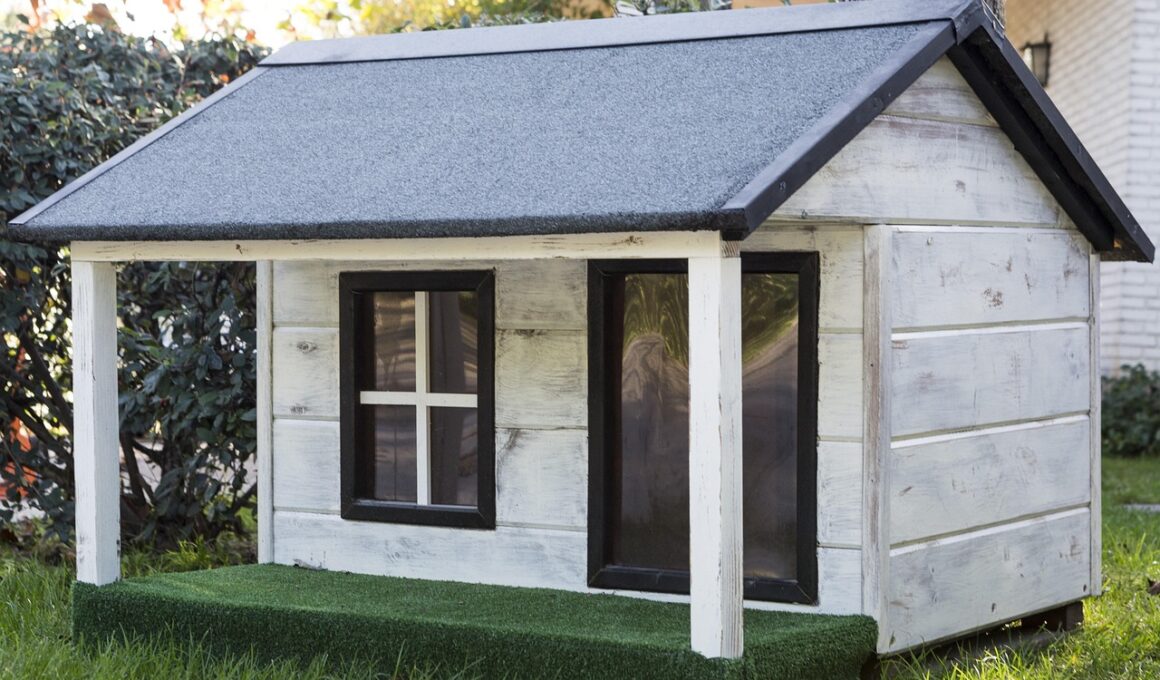How to Measure Your Dog for the Perfect Indoor House
Choosing an indoor dog house that suits your dog perfectly requires precise measurements. Start by measuring your dog from the tip of its nose to the base of its tail. This length will help you determine the internal space needed inside the house. Next, measure your dog’s height while standing. It’s important to know the head height when sitting to ascertain the necessary height of the dog house. Be sure to include some extra space to accommodate any breed differences. Checking your dog’s weight can help narrow down options for the size of the house. Different dog houses have weight limits. Consider asking your veterinarian for any weight-specific advice tailored to your dog’s breed, especially if it’s on the larger side. These measurements should provide a solid base for selecting an appropriately sized house. Not only does comfort matter, but so does the style to match your home. With the right measurements, you can choose a style that fits your home interior while ensuring comfort for your dog. This ensures a positive environment for your pet indoors, creating a safe haven for rest.
After determining the proper dimensions, consider the type of indoor dog houses available. The most popular materials for indoor dog beds include MDF, plastic, and even plush fabric. Each material has its advantages and drawbacks. For example, a wooden house may provide sturdiness and durability, while a plush one offers softness and comfort. Look for houses that come with removable cushions or inner padding. This makes cleaning and maintaining hygiene easier, as pets can sometimes be messy. Additionally, consider how the dog house fits the decor of your home. You may want to choose a style and color that complements your interiors. Functionality is equally important; a house that is too large may occupy valuable space. Check the layout of your room and find the optimal place for the house. It should not obstruct movement. Furthermore, ensure there’s enough ventilation in the area to promote a healthy atmosphere. Indoor dog houses should be easy to enter and exit, as well as secure and stable. A house that serves as a personal retreat offers your dog a comfortable and safe space away from the hustle and bustle.
Understanding Breed Size Considerations
When selecting an indoor dog house, understanding the breed size of your dog plays a crucial role. Some breeds grow considerably larger than others, while low breeds like Dachshunds may require a lower entrance. Take a moment to research any specific requirements based on your dog’s breed, especially if it belongs to a large or giant breed. Giant breeds like Great Danes may need extensive floor space to move comfortably, while smaller breeds feel confined in a vast space. Thicker breeds should have a wider entrance to avoid wedged situations. Additionally, observe how your dog relaxes in various positions and incorporate that into your measurements. For instance, dogs tend to curl when they sleep; ensure the interior accommodates this resting posture. Certain breeds might be prone to anxiety, making a cozier setting more appealing. Researching your dog’s unique needs allows you to optimize the indoor space while ensuring your pet’s comfort. This leads to a healthier, happier dog. A satisfied dog will thrive in a space designed specifically for their needs, providing an enriching experience.
As you consider the ideal indoor dog house, remember to think about positioning. The location where the house is placed can impact your dog’s comfort. It should be situated away from drafts or direct sunlight. Being proactive in creating a conducive environment is essential for your dog’s relaxation. Ensuring the house is placed in a quiet area can help reduce noise, which in turn promotes a calm effect. Consider using rugs or non-slip mats beneath the house to prevent shifting and to offer additional cushioning. If your dog tends to chew, select materials resistant to wear. Monitor your dog’s behaviors closely and make adjustments as needed regarding the house placement. If your dog appears anxious or reluctant to enter, consider changing its location. Also, provide some friendly commands and encouragement to help your dog view the house as a safe haven. Each dog has individual needs, and adjusting based on their responses will make the living arrangements more comfortable. By investing time in these considerations, you pave the way for a more enjoyable indoor canine experience.
Choosing the Right Style and Design
Once you have measured your dog and decided on key considerations, it’s time to explore styles and designs. The aesthetic appeal of the dog house can blend seamlessly with your interior design. Think about whether you prefer traditional wooden houses, modern minimalist styles, or vivid colors that pop. Consider if you want a house that resembles furniture to enhance visual cohesion in your space. It is essential to evaluate the house along with your entire room’s theme. Selecting a house that fits your overall decor elevates the living space. Wooden houses often create a rustic charm, while plush or contemporary designs can add a cozy feeling to the room. Ensure the house complements your decor while still serving its purpose effectively. Safety features should also be prioritized. Edges should be smooth to prevent injuries and material should be non-toxic. An attractive yet functional design offers a reward, as both you and your dog can enjoy. Ultimately, stylish selections invite the creativity of your home while being adjustable for your pet’s needs, ensuring comfort and satisfaction.
To finalize your decision, consider customer reviews and expert opinions. Reviews from other dog owners provide insights into the effectiveness of certain indoor dog houses and their suitability for specific breeds. Seek details regarding durability, ease of assembly, and maintenance. A good dog house should not be difficult to assemble or too cumbersome to clean, as hygiene is paramount. Verify if the dog house is easy to move and does not require heavy lifting. You can also check if the handle design promotes mobility. Attending pet expos or visiting local pet stores gives you a chance to see various models in person. Consult with a salesperson about recommendations based on your dog’s size and lifestyle. Additionally, social media channels or pet forums can be valuable resources for gathering real-life experiences. Joining groups focused on pet housing can lead to useful advice for first-time buyers. By leveraging community knowledge, you can make well-informed decisions. This process will guide you in buying a fitting indoor dog house that satisfies both your expectations and your dog’s needs.
Final Thoughts on Comfort and Safety
After ensuring a snug fit through your measurements and selections, focus on guaranteeing your dog’s comfort and safety. Every breed holds unique characteristics, and your indoor house should reflect these traits substantially. Consider adding blankets or cushions to enhance coziness within the house. These elements offer security by creating a personal sanctuary for your pet. Safety should always remain the absolute priority; avoid sharp edges or any material that might irritate your dog’s skin. Inspect the house periodically for any wear and tear as your dog uses it. Regularly check for any potential hazards that could pose risks, including loose components or unsuitable structures. If issues arise, timely repairs help avoid further complications. It’s beneficial also to establish a routine for cleaning, especially for dogs that shed. Keeping the house tidy promotes not just a hygienic space but also encourages your dog to engage with its indoor house. Ultimately, a well-measured, stylish, and comfortable dog house fosters a deeper bond between you and your dog, enhancing its experience within the home.
Once all considerations have been addressed, reward your dog with love and patience as it adapts to its new indoor dog house. Making this transition smooth creates a positive experience altogether. Allow your pet to explore it on its own terms, fostering familiarity. Introduce toys or treats inside the house to help associate it with happy moments. Remember that a comfortable indoor house offers a sanctuary while encouraging restful behaviors. Whichever design you choose, the emphasis should always remain on comfort, safety, and ease of use. In conclusion, your efforts of measuring and selecting the right dog house positively impact your pet’s well-being and happiness. A happy dog leads to a joyful household, where both your bond and satisfaction flourish. The indoor dog house represents more than just a resting spot; it serves as a personal retreat that provides solace and security, essential for a thriving happy pet and a tranquil home. When all aspects are considered and executed, your indoor dog house becomes an enriching experience, contributing significantly to your dog’s quality of life. With this knowledge, you can confidently embrace this crucial aspect of responsible pet ownership.


